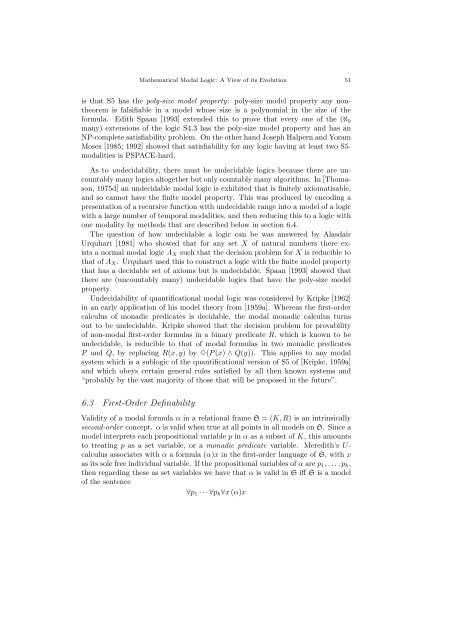MATHEMATICAL MODAL LOGIC: A VIEW OF ITS EVOLUTION
MATHEMATICAL MODAL LOGIC: A VIEW OF ITS EVOLUTION
MATHEMATICAL MODAL LOGIC: A VIEW OF ITS EVOLUTION
You also want an ePaper? Increase the reach of your titles
YUMPU automatically turns print PDFs into web optimized ePapers that Google loves.
Mathematical Modal Logic: A View of its Evolution 51is that S5 has the poly-size model property: poly-size model property any nontheoremis falsifiable in a model whose size is a polynomial in the size of theformula. Edith Spaan [1993] extended this to prove that every one of the (ℵ 0many) extensions of the logic S4.3 has the poly-size model property and has anNP-complete satisfiability problem. On the other hand Joseph Halpern and YoramMoses [1985; 1992] showed that satisfiability for any logic having at least two S5-modalities is PSPACE-hard.As to undecidability, there must be undecidable logics because there are uncountablymany logics altogether but only countably many algorithms. In [Thomason,1975d] an undecidable modal logic is exhibited that is finitely axiomatisable,and so cannot have the finite model property. This was produced by encoding apresentation of a recursive function with undecidable range into a model of a logicwith a large number of temporal modalities, and then reducing this to a logic withone modality by methods that are described below in section 6.4.The question of how undecidable a logic can be was answered by AlasdairUrquhart [1981] who showed that for any set X of natural numbers there existsa normal modal logic Λ X such that the decision problem for X is reducible tothat of Λ X . Urquhart used this to construct a logic with the finite model propertythat has a decidable set of axioms but is undecidable. Spaan [1993] showed thatthere are (uncountably many) undecidable logics that have the poly-size modelproperty.Undecidability of quantificational modal logic was considered by Kripke [1962]in an early application of his model theory from [1959a]. Whereas the first-ordercalculus of monadic predicates is decidable, the modal monadic calculus turnsout to be undecidable. Kripke showed that the decision problem for provabilityof non-modal first-order formulas in a binary predicate R, which is known to beundecidable, is reducible to that of modal formulas in two monadic predicatesP and Q, by replacing R(x, y) by ✸(P (x) ∧ Q(y)). This applies to any modalsystem which is a sublogic of the quantificational version of S5 of [Kripke, 1959a]and which obeys certain general rules satisfied by all then known systems and“probably by the vast majority of those that will be proposed in the future”.6.3 First-Order DefinabilityValidity of a modal formula α in a relational frame S = (K, R) is an intrinsicallysecond-order concept. α is valid when true at all points in all models on S. Since amodel interprets each propositional variable p in α as a subset of K, this amountsto treating p as a set variable, or a monadic predicate variable. Meredith’s U-calculus associates with α a formula (α)x in the first-order language of S, with xas its sole free individual variable. If the propositional variables of α are p 1 , . . . , p k ,then regarding these as set variables we have that α is valid in S iff S is a modelof the sentence∀p 1 · · · ∀p k ∀x (α)x
















